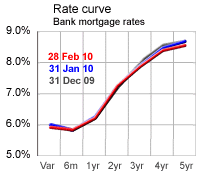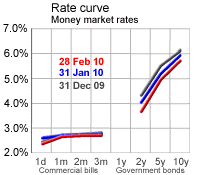Opinion: Long-term rates have bottomed, harder to pick bottom of short-term rates
The developing picture of where NZ interest rates will be in 12 and 24 moths time is still not all that clear, but as time passes the movements at the long-end of the yield curve is certainly telling us something.
The 10-year swap rates are up another 15 basis points over this last week from 4.75% to 4.90% as US 10-year Treasury Bonds increase to over 3.00%. Since the record lows of 4.33% in 10-year swaps in late-January, the market has lifted nearly 60 basis points in yield. Given the massive supply of US and NZ Government Bonds that are going to be coming onto the market over the coming few years, bond investors are already voting with their feet and demanding higher yields on the secondary market.
The flight to quality and safety of Government Bonds that continues around the globe is largely being invested in the short-end, 90 days to 2 year maturities. This weight of investor money is pushing down short-term rates.
 Adding to the yield curve steepening pressure are fixed interest fund managers shortening the duration of their investment portfolios i.e. selling longer-dated bonds to buy shorter-dated bonds. On some sunny day in the future (I do not know when) NZ bond and swap investors will go over the tipping point where they say that a 3.00% return from the short-end is not as good as investing long-term at 5% or 6%.
Adding to the yield curve steepening pressure are fixed interest fund managers shortening the duration of their investment portfolios i.e. selling longer-dated bonds to buy shorter-dated bonds. On some sunny day in the future (I do not know when) NZ bond and swap investors will go over the tipping point where they say that a 3.00% return from the short-end is not as good as investing long-term at 5% or 6%.
When this happens the yield curve will flatten out with short-term rates increasing up towards long-term interest rates. This behaviour by investors (whenever it happens) will signal the end of low interest rates and significant increases in short-term rates. That timing will also be determined by the release of more positive economic data.
In the second half of 2009 increased export activity could well return NZ GDP growth to a positive number. Don’t hold your breath however waiting for confirmation of this in official GDP numbers, watch for business confidence trends, consumer confidence and export commodity prices as early lead economic indicators.
 Even before these start to recover, watch for improvement in PMI Indices (factory orders) in the US, China, Europe and the UK. The earliest indicator may well be a recovery upwards in the NZ dollar exchange rate, reflecting investor/trader confidence that NZ could turn the economic corner first.
Even before these start to recover, watch for improvement in PMI Indices (factory orders) in the US, China, Europe and the UK. The earliest indicator may well be a recovery upwards in the NZ dollar exchange rate, reflecting investor/trader confidence that NZ could turn the economic corner first.
As home mortgage interest rates reach the 5% big figure for 1 to 5 year terms, the demand to pay fixed in the swaps market will only increase and become one-sided. Corporate borrowers seeking to fix interest rates to high levels must be ahead of that eventuality.
This article has kindly been republished courtesy of interest.co.nz. To view this article and other news updates from
Posted: 5 Mar 2009
News articles
Browse articles
by date


